An air plant will bloom once only in its lifetime. Even though this represents the peak of their life and they won’t grow any further from this point, air plants will produce pups or offsets over their lifespan.
What is the lifespan of air plants?
An air plant lifespan is between 2 to 5 years. Air plants are perennials, which means that they live for more than two years. Their life expectancy will be influenced by the Tillandsia species and growth conditions (environment, light, temperature, etc).
Keeping your air plant healthy and living long is rewarding in so many ways. Let’s see how to increase their lifespan and how to revive them!
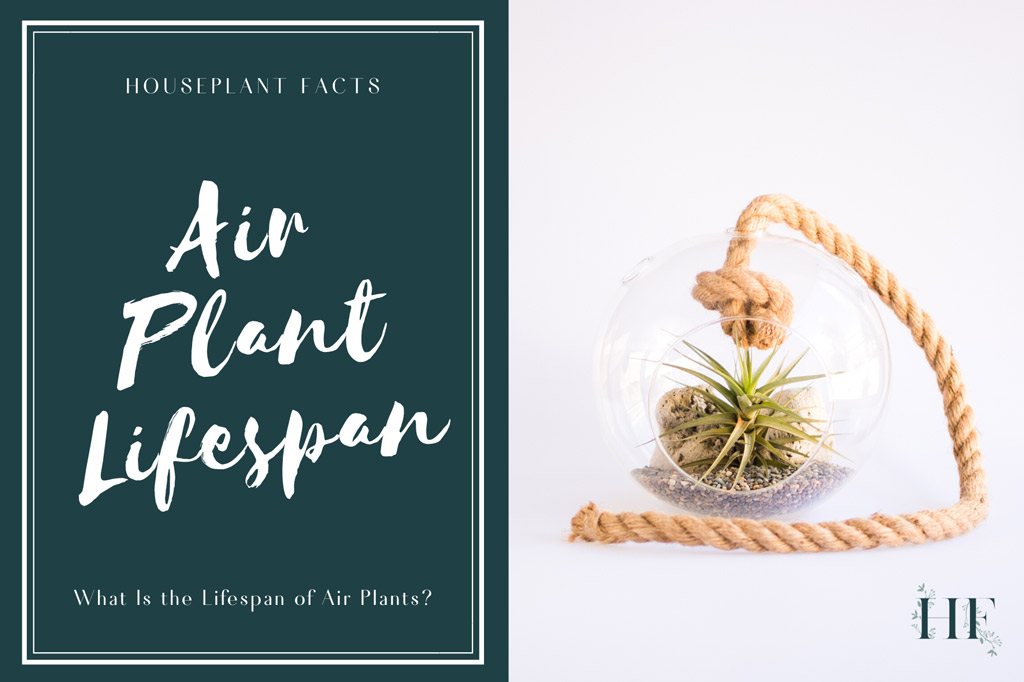
Air Plant Lifespan
When you have one or more air plants, you’ll want to know more about them so you can continue to provide the appropriate care for your plants.
This is why knowing about the lifespan and life cycle of air plants (how long you can expect them to live) is a great starting point.
What is The Lifespan of Air Plants?
Tillandsias, commonly known as air plants, are perennial plants. This means that they typically live for more than two years (source), with their lifespan ranging between 2 to 5 years.
However, their lifespan varies depending on the type of air plant and also the growing conditions. In their natural habitat, they live on the branches of trees, in deserts and on other substrates (other surfaces they can grow on).
Air plants bloom once during their lifetime and this blooming represents the peak of their life cycle – their maturity.
Once they blossom, the flowers can last for several months, depending on the species. But, when the flowers start to fade and wilt, the air plant will start to perish. Before they die, air plants produce pups or offsets to continue the same growth cycle.
Although the mother dies, you can remove the pups from the mother plant and grow them individually. The process of separating the pups from the mother is called “division” and it’s a way to propagate air plants.
Alternatively, you can leave those pups together, so they form a cluster or clump (also known as “tillandsia balls”).
Read also: Air Plant Life Cycle, Reproduction and Growth Rate.
Air Plant Dying
Although it might seem obvious, I get questions like these:
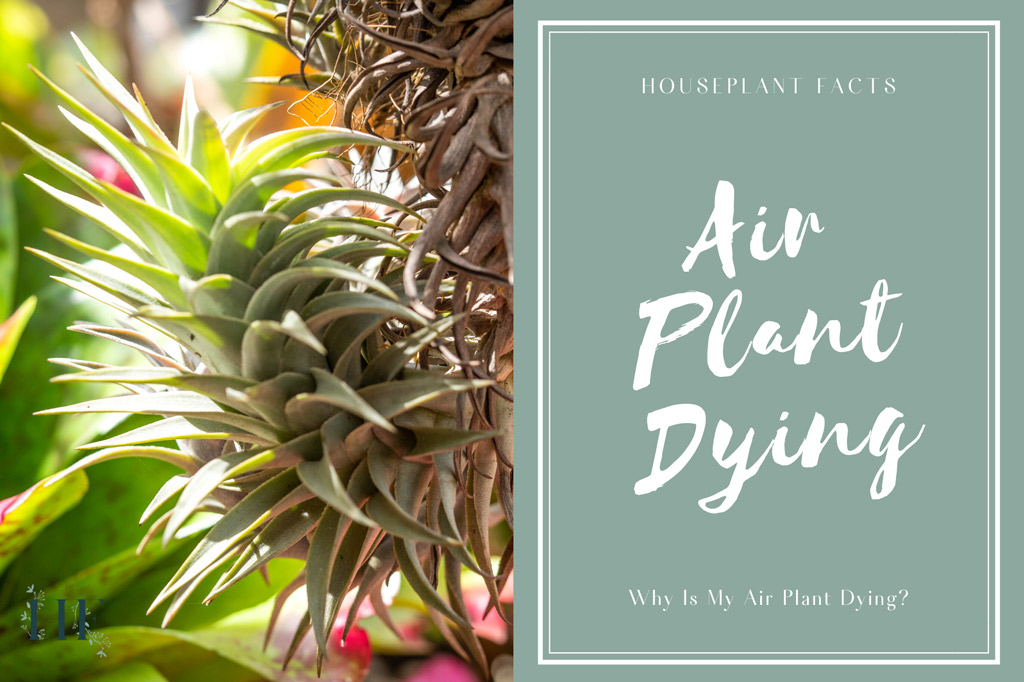
So, how do you know if your air plant is dying?
Signs of a Dying Air Plant
Here are the most common signs that your air plant is dying:
- When the leaves are drying up, wrinkling or rolling up.
- When the core is rotting. If the air plant succumbs to rot, the plant’s base turns black or brown.
How Do You Know When Air Plants Are Dead?
When is an air plant dead?
Here’s how to tell if an air plant is dead: when you pluck out the dead leaves, the entire air plant falls apart.
Although knowing that your air plant is dead is often easier than identifying the why.
Why Is My Air Plant Dying? (And What to Do About It)
Your air plant could be dying due to:
- Underwatering: The air plant starts to dry out and wrinkle or roll up its leaves.
- Overwatering: The air plant begins to turn black or brown at the base and rots. Eventually, the leaves fall off from the centre.
- Sunburn: Although air plants can take some direct sunlight, they need to acclimate first. If you suddenly move your air plant to a sunny spot, it’s likely that your plant gets a sunburn. The leaves can look bleached and the leave tips can get crispy.
- The life cycle is completed: Air plants start dying after flowering, but this doesn’t happen immediately – they can still stick around for years. After blooming and producing pups (no matter what you do) your Tillandsia will eventually die, but not before it has given all its energy to growing the offsets. This could take up to several years depending on the species. In this case, it’s a natural death, i.e., it’s part of a Tillandsias life cycle.
I just said “no matter what you do”… but there are some tips that you can follow to revive and extend your air plant lifespan! 🙂
Read also: 13 Common Air Plant Problems, Pests and Diseases – includes tips on identifying the signs and how to prevent the problems.
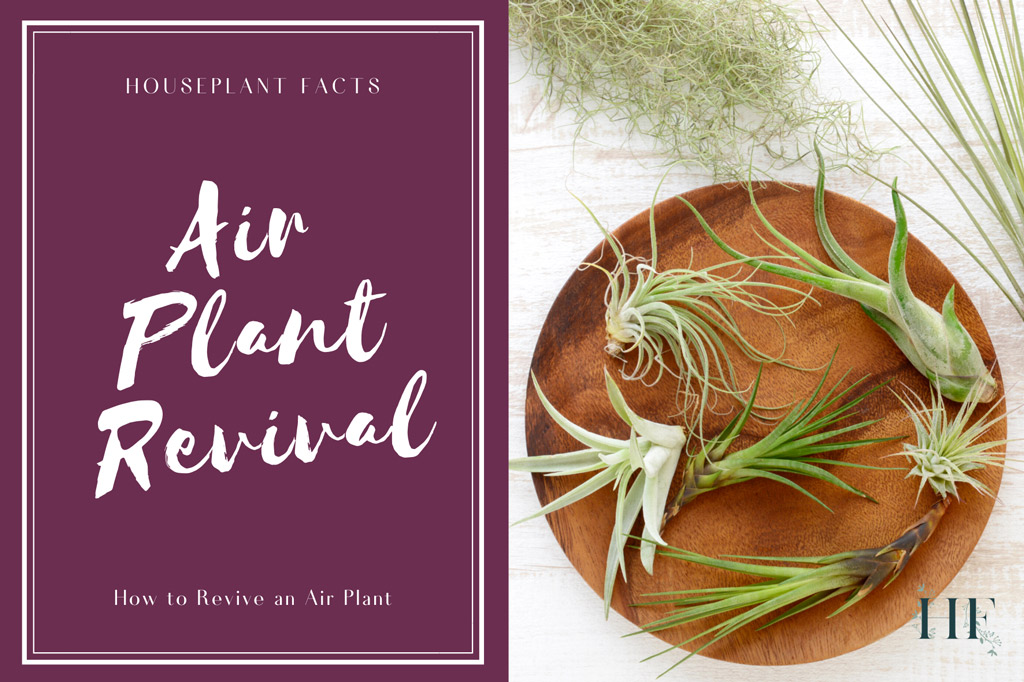
How to Revive an Air Plant
Can you revive a dead air plant?
If an air plant is dead, there’s no way to revive it.
However, you might be able to nourish it back to health if the plant is not entirely damaged.
An air plant revival is an option when you see splashes of living colour on the leaves. That’s a sign of hope. 🙂
Look for green, healthy leaves on the plant. But if there aren’t any, it’s okay to compost (or discard) your air plant.
How do you revive an air plant, though?
There are two easy options to inject life into your air plants:
- Step 1: Soak the air plant overnight.
- Step 2: Remove the dead leaves.
1) Soaking an Air Plant Overnight
Soaking your Tillandsia is the best way to revive air plants, and the most effective method of soaking is to do it overnight.
What you need:
- A bowl – big enough to submerge your air plant completely.
- Lukewarm water.
- Garden twine (a soft cord that doesn’t damage the plant).
- A pebble or rock (some kind of weight).
- Paper towel.
- Your air plant! 🙂
Here’s how to do it, step by step:
- Pour lukewarm water into a bowl. Make sure it is deep enough to soak the entire air plant and that it allows a couple of inches above the plant.
- Take your air plant and submerge it. The key is to keep the plant immersed in water. So, to avoid it from floating upwards, you can gently tie the air plant to a rock using some garden twine. This will keep it underwater for the entire night.
- Ensure that the plant is completely covered. You can always pour additional water if needed, but make sure it’s lukewarm.
- Keep your air plant underwater for 6 to 8 hours. This will give them plenty of time to soak up all the moisture and nutrients.
- Once your Tillandsia has finished soaking, it’s time to remove it from the bowl. Make sure to shake off any extra moisture or dampness on the air plant.
- Finally, let your air plant dry on a paper towel for 4 to 5 hours in a well-lit place. But avoid direct sunlight, extreme heat (like a heater or radiator) and frost (near a windowsill during winter). This last step is crucial because dampness can encourage rotting, which is a death sentence.
Insider Tip: Use lukewarm water for soaking your air plants. The warm temperature will provide a gentle bath for the air plants to revive. Try to maintain a temperature between 18º to 24ºC (65º to 75ºF).
It’s possible that soaking them once might not be enough.
Check your air plant for leaf curling after 2 to 3 days following the overnight soaking.
If the air plant still has curled leaves, you can repeat the soaking process.
Once your air plant is back to life and doing well, follow a watering routine that suits your Tillandsia.
Read also: Air Plant Watering Guide – How to Water and Mist Tillandsias.
2) Removing Dead Leaves From an Air Plant
The other step that you can take is to remove dead leaves.
What you need:
- Gardening scissors (smaller scissors that suit jobs like this one).
- Your air plant with brown leaves.
Here’s how to do it, step by step:
- Simply cut off the dead leaves.
- You can also do this by gently tugging at the leaves, but you need to be careful not to plug out the whole plant. If tugging causes the entire plant to fall apart, that, unfortunately, means your air plant is already dead.
There are many reasons why you want to tug off dead leaves:
- Leaving dead leaves on a plant restricts air circulation and sunshine absorption for healthy leaves.
- Plucking out dead leaves will also keep plant pests at bay since some pests are heavily attracted to decaying leaves. The problem will soon spill into the healthier leaves.
- Lastly, removing dead leaves will allow healthier leaves to grow.
Since air plants get their nutrients and moisture from the atmosphere, removing those dead leaves can be enough for your air plant to jump back to life. 🙂
Read also: 13 Common Air Plant Problems, Pests and Diseases.
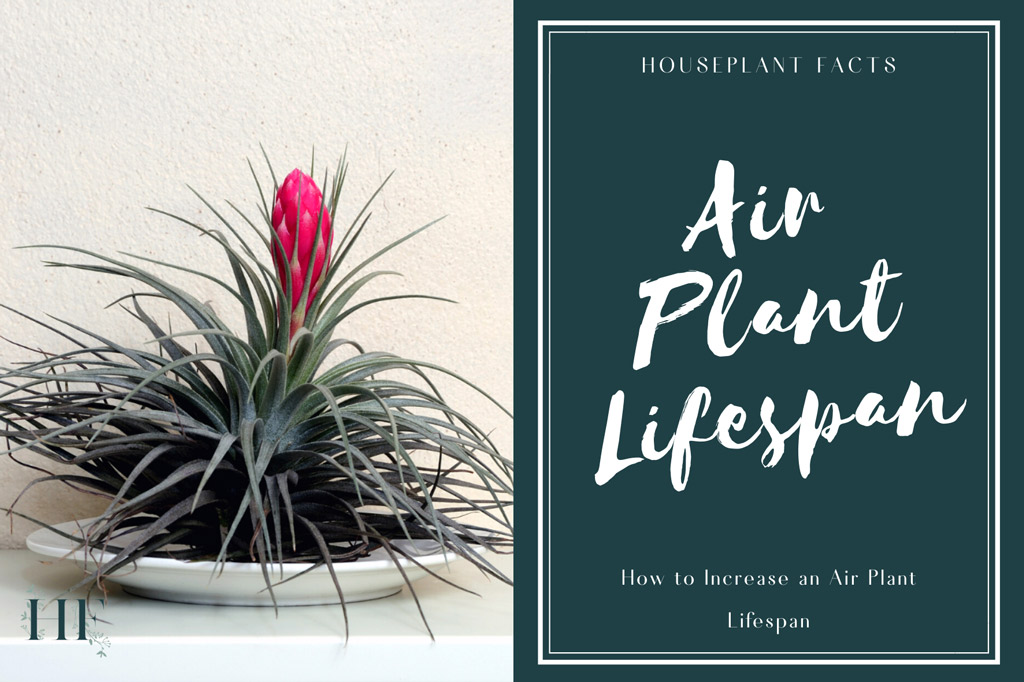
How to Increase an Air Plant Lifespan
Finally, the following 5 care tips will show you how to increase an air plant lifespan.
1) Nurture The Blooming Air Plant
As expected, a blooming air plant will need a little more water than usual. This is because the plant is focusing all its energy on the flowers and the production of offsets or pups.
Insider Tip: To lengthen the life of the air plant bloom, try to keep the flower dry when watering. i.e., don’t get water into the flower.
Since having the flower soaked in water will cause it to wilt or rot, instead of soaking up your air plant while it’s blooming, you can:
- Option A: Mist your air plant using a spray bottle or mister.
- Option B: Hold the blooming air plant under running lukewarm water to wet only the leaves.
2) Water According to Air Plant Type
Air plants do need water. But, you might ask:
How much water does my air plant need?
There are many different Tillandsia varieties from a range of different native habitats.
One of the key factors in determining the type of care and environment your Tillandsia will prefer is whether it is a mesic or xeric air plant – or something in between.
Mesic and xeric terms refer to the type of native environment that the Tillandsia originates from and will therefore prefer to thrive.
- Mesic Air Plants:
- Their natural habitat is the terrestrial shade or in the lower levels of the forests (like South American rainforests).
- Originate from climates with moderate humidity.
- Prefer frequent watering and indirect or filtered sunlight.
- Often have smooth green leaves with less visible trichomes.
- Xeric Air Plants:
- Come from drier or dessert-like habitats and mostly live on the upper floors of the woods and on rocks.
- Live in precipitation-poor areas with high humidity.
- Prefer less watering and bright direct sunlight.
- Often have fuzzy-looking grey or light green leaves with abundant trichomes.
Read also: Air Plant Watering Guide – How to Water and Mist Tillandsias.
3) Provide the Appropriate Environment
When looking at the environment of an air plant, I’m referring to light levels, humidity levels and room temperature.
Again, depending on what type of air plant you have (xeric or mesic), it will thrive in different environments.
Mesic air plants prefer moderate humidity and indirect or filtered sunlight. On the other hand, xeric air plants will thrive in high humidity and bright direct sunlight.
Read also: Air Plant Light Guide – How Much Light Do They Need.
4) Trim and Groom Your Air Plant
It’s part of an air plants life cycle to get some brown leaves. Over time, some of the lower leaves of these epiphytes will dry up (becoming brown) or become withered due to age, climatic conditions, etc.
As I mentioned in the Removing Dead Leaves From an Air Plant section, you can help your air plant by simply pulling off or cutting away any dead leaves.
This will promote the growth of new leaves and encourage healthier development in the current leaves.
5) Apply Fertilizer (Optional)
It is not a necessity to fertilize air plants. However, fertilizing your air plants occasionally will:
- Speed up the reproduction of pups.
- Encourage more vibrant blooms.
- Preserve their lives and stay healthy.
Here’s what to do when choosing a fertilizer for air plants:
- Use a water-soluble fertilizer.
- Choose a non-urea-based fertilizer. Nitrogen should be in the form of ammonium or nitrate, not urea (since urea needs the bacteria in the soil to break it down).
- Avoid copper and zinc micronutrients since they are toxic to air plants.
My recommendation is an air plant specific fertilizer like this one.
Here’s how to fertilize your air plant:
- Use 1/4 the strength recommended on the label.
- Fertilize only once a month during the growing season. You can do it during the soaking sessions.
Read also: Air Plant Nutrients Guide – When to Fertilize Tillandsias.
P.S. For more about how to keep air plants alive, check our Air Plant Care Guide.

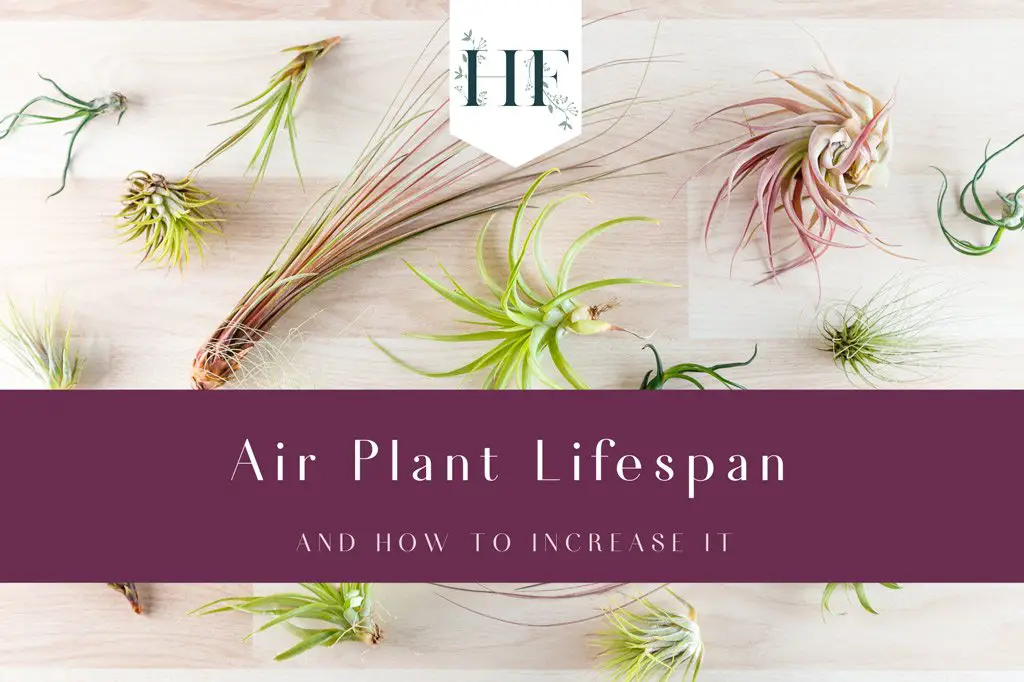

Never use tap water to submerge your air plants there are various chemicals agents in the water that will strip the plant of its trichomes and ultimately kill the plant. Use rain water or even better if you have a fish tank use waste water from your tank it’s an amazing nutrient rich feed!